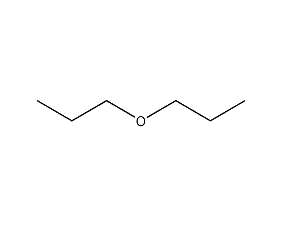
Structural formula
| Business number | 033H |
|---|---|
| Molecular formula | C6H14O |
| Molecular weight | 102.17 |
| label |
di-n-propyl ether, propoxypropane, n-propyl ether, Di-n-propyl ether, Dipropyl ether, n-propyl ether, 1,1′-oxybispropane, Propoxypropane, Ether solvents, linear compound |
Numbering system
CAS number:111-43-3
MDL number:MFCD00009376
EINECS number:203-869-6
RTECS number:UJ5125000
BRN number:1731312
PubChem number:24847025
Physical property data
1. Properties: Colorless liquid, with ether aroma, highly volatile. [1]
2. Melting point (℃): -122[2]
3. Boiling point (℃): 89~91[3]
4. Relative density (water = 1): 0.74[4]
5. Relative true gas density (air=1): 3.53[5]
6. Saturated vapor pressure (kPa): 8.33 (25℃)[6] sup>
7. Critical pressure (MPa): 3.028[7]
8. Octanol/water partition coefficient: 2.03[8 ]
9. Flash point (℃): 21 (CC) [9]
10. Ignition temperature (℃): 188[10]
11. Explosion upper limit (%): 7.0[11]
12. Explosion lower limit (% ): 1.3[12]
13. Solubility: Slightly soluble in water, soluble in most organic solvents such as ethanol and ether. [13]
14. Relative density (20℃, 4℃): 0.7466
15. Relative density (25℃, 4℃): 0.7419
16. Refractive index at room temperature (n25): 1.3780
17. Eccentricity factor: 0.370
18. Solubility parameter (J·cm-3)0.5:15.755
19. van der Waals area (cm2·mol-1): 1.022×1010
20. van der Waals volume (cm3·mol– 1): 71.960
Toxicological data
1. Acute toxicity[14]
LD50: 204mg/kg (mouse vein)
2. Irritation No information available
Ecological data
1. Ecotoxicity No data available
2. Biodegradability No data available
3 .Non-biodegradability[15] In the air, when the concentration of hydroxyl radicals is 5.00×105/cm3 When, the degradation half-life is 21d (theoretical).
4. Bioconcentration[16] BCF: 21 (theoretical)
Molecular structure data
1. Molar refractive index: 31.59
2. Molar volume (cm3/mol): 133.9
3. etc.�Specific volume (90.2K): 290.5
4. Surface tension (dyne/cm): 22.1
5. Polarizability (10-24 cm3): 12.52
Compute chemical data
1. Reference value for hydrophobic parameter calculation (XlogP): None
2. Number of hydrogen bond donors: 0
3. Number of hydrogen bond acceptors: 1
4. Number of rotatable chemical bonds: 4
5. Number of tautomers: none
6. Topological molecule polar surface area 9.2
7. Number of heavy atoms: 7
8. Surface charge: 0
9. Complexity: 23.4
10. Number of isotope atoms: 0
11. Determine the number of atomic stereocenters: 0
12. Uncertain number of atomic stereocenters: 0
13. Determine the number of chemical bond stereocenters: 0
14. Number of uncertain chemical bond stereocenters: 0
15. Number of covalent bond units: 1
Properties and stability
1. It has the tendency to form explosive peroxide, so it cannot be evaporated to dryness. Non-corrosive to metals. Similar to diethyl ether, auto-oxidation occurs under the action of light and oxygen in the air, forming explosive peroxide. Propyl ether has strong degreasing ability and should avoid contact with skin.
2. Stability[17] Stable
3. Incompatible substances[18] Strong oxidants, oxygen, halogens, perchloric acid, sulfur, sulfides
4. Conditions to avoid contact [19] Contact with air
5. Polymerization hazard[20] No polymerization
Storage method
Storage Precautions[21] Stored in a cool, ventilated warehouse. Keep away from fire and heat sources. The storage temperature should not exceed 29℃. The packaging must be sealed and must not come into contact with air. They should be stored separately from oxidants, halogens, etc., and avoid mixed storage. It should not be stored in large quantities or for long periods of time. Use explosion-proof lighting and ventilation facilities. It is prohibited to use mechanical equipment and tools that are prone to sparks. The storage area should be equipped with emergency release equipment and suitable containment materials.
Synthesis method
1. The dehydration temperature obtained by thermal dehydration of n-propanol and sulfuric acid is 140-150°C. Benzenesulfonic acid can also be used instead of sulfuric acid. In addition, propyl ether can be produced by heating the addition compound of boron trifluoride and alcohol; n-propyl alcohol can be dehydrated in the gas phase at 200°C under the action of a nickel catalyst supported on magnesium oxide.

2. n-Propanol is contained in Under the action of nickel catalyst on magnesium oxide, gas phase dehydration is performed at 200°C to obtain propyl ether. ![]()
Purpose
1. Used as solvents and raw materials for organic synthesis, and as chemical reagents in analytical chemistry.
2. Used in organic synthesis and also used as solvent. [22]

 微信扫一扫打赏
微信扫一扫打赏

